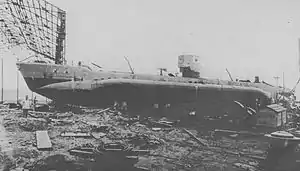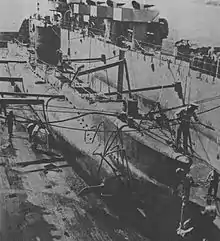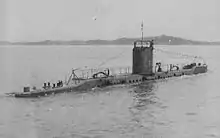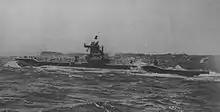Type 3 submergence transport vehicle
The Type 3 submergence transport vehicle (三式潜航輸送艇, San-Shiki Senkō Yusōtei) was a class of transport submarines built for the Imperial Japanese Army (IJA) during the Second World War. The IJA planned to build over 400 boats, however only 38 boats were completed until the end of war. The IJA called them Maru Yu (マルゆ).
 Yu 1 in Hitachi Ltd., Kasado Factory (1943) | |
| Class overview | |
|---|---|
| Name: | Type 3 submergence transport vehicle |
| Builders: |
|
| Operators: |
|
| Subclasses: |
|
| Built: | 1943–45 |
| In commission: | 1943–45 |
| Planned: | 400 and more |
| Completed: | 38 |
| Lost: | 5 |
| Scrapped: | 33 |
| General characteristics Yu I type | |
| Type: | Transport submarine |
| Displacement: |
|
| Length: | 41.40 m (135 ft 10 in) overall |
| Beam: | 3.90 m (12 ft 10 in) |
| Draft: | 3.00 m (9 ft 10 in) |
| Propulsion: |
|
| Speed: |
|
| Range: | |
| Test depth: | 100 m (330 ft) |
| Capacity: | 24 tons freight or 40 troops |
| Complement: | 23 |
| Armament: |
|
| General characteristics Yu II type [1] | |
| Type: | Transport submarine |
| Displacement: |
|
| Length: | 55.00 m (180 ft 5 in) overall |
| Beam: | 7.00 m (23 ft 0 in) |
| Draft: | 3.13 m (10 ft 3 in) |
| Propulsion: |
|
| Speed: |
|
| Test depth: | 150 m (492 ft 2 in) |
| Capacity: | 40 tons freight |
| Armament: | |
Construction
In 1943 the IJA decided to build a transport submarine for themselves, because the IJA was soundly beaten in the Solomon Islands campaign and needed a way to supply the isolated garrisons on the Pacific islands.
Boats in classes
Yu I type
The class consists of four unofficial subclasses resulting from manufacturing differences among the contracted builders. The manufacturer may be discerned by the appearance of the sail.
Yu 1-class


Basic model of Yu I type. First boat Yu 1 was prototype of the Yu I type boats. The Hitachi-Kasado Factory built all of the Yu 1-class boats. Their sail was closed.
- Yu 1, laid down in February 1943, completed on 31 October 1943, lost in an accident at Lingayen Gulf on 2 January 1945.
- Yu 2, sunk by USS Pringle, Renshaw, Waller and Saufley at Ormoc Bay on 27 November 1944.
- Yu 3, lost in an accident at Lingayen Gulf in January 1945, salvaged by USS Grasp on 18 January 1945, carried out by USS Rushmore in May 1945.
- Yu 4, survived war.
- Yu 5, survived war.
- Yu 6, assigned Detachment 2, Transport Submarine Group on 13 February 1945, survived war.
- Yu 7, assigned Detachment 2, Transport Submarine Group in November 1944, survived war.
- Yu 8, survived war.
- Yu 9, survived war.
- Yu 10, assigned Detachment Kuchinotsu, Transport Submarine Group on 15 May 1945, survived war.
- Yu 11, assigned Detachment Kuchinotsu, Transport Submarine Group on 15 May 1945, assigned Detachment Mikuriya in June 1945, survived war.
- Yu 12, assigned Detachment Kuchinotsu, Transport Submarine Group on 15 May 1945, survived war.
- Yu 13, assigned Detachment Mikuriya in June 1945, survived war.
- Yu 14, assigned Detachment Kuchinotsu, Transport Submarine Group on 15 May 1945, assigned Detachment Mikuriya in June 1945, survived war.
- Yu 16, survived war.
- Yu 17, survived war.
- Yu 18, survived war.
- Yu 19, survived war.
- Yu 20, survived war.
- Yu 21, survived war.
- Yu 22, survived war.
- Yu 23, survived war.
- Yu 24, survived war.
- Yu 25, incomplete until the end of the war.
Yu 1001-class

The Japan Steel Works-Kaita Factory built all of the Yu 1001-class boats. They were equipped with an open-top sail.
- Yu 1001, launched on 27 March 1944, completed on 15 June 1944, assigned Detachment 2, Transport Submarine Group in November 1944, sunk by air raid at Shimoda on 12 August 1945.
- Yu 1002, assigned Detachment 2, Transport Submarine Group on 11 February 1945, survived war.
- Yu 1003, assigned Detachment 2, Transport Submarine Group on 11 February 1945, survived war.
- Yu 1005, assigned Detachment 2, Transport Submarine Group on 13 February 1945, survived war.
- Yu 1006, survived war.
- Yu 1007, assigned Detachment Kuchinotsu, Transport Submarine Group on 15 May 1945, assigned Detachment Mikuriya in June 1945, survived war.
- Yu 1008, survived war.
- Yu 1009, survived war.
- Yu 1010, survived war.
- Yu 1011, incomplete until the end of the war.
- Yu 1012, incomplete until the end of the war.
- Yu 1013, incomplete until the end of the war.
- Yu 1014, incomplete until the end of the war.
Yu 2001-class

The Andō Iron Works-Tsukishima Factory build all of the Yu 2001-class boats. First boat (Yu-2001) was the second prototype of the Yu I type boats. They fitted a deck house root to the sail for improved crew comfort.
- Yu 2001, launched on 12 February 1944, survived war.
- Yu 2002, launched on 31 March 1945, survived war.
- Yu 2003, incomplete until the end of the war.
- Yu 2004, incomplete until the end of the war.
- Yu 2005, incomplete until the end of the war.
- Yu 2006, incomplete until the end of the war.
Yu 3001-class
The Chōsen Machinery-Jinsen Factory build all of the Yu 3001-class boats.
- Yu 3001, launched on 10 April 1944, completed on 2 August 1944, survived war.
- Yu 3002, sunk by rough weather in 1945.
- Yu 3003, survived war.
- Yu 3005, incomplete until the end of the war.
- Yu 3006, incomplete until the end of the war.
- Yu 3007, incomplete until the end of the war.
- Yu 3008, incomplete until the end of the war.
- Yu 3009, incomplete until the end of the war.
- Yu 3010, incomplete until the end of the war.
Yu II type
Improved model of the Yu I type. Yu II was built by Kampon technical guidance. The IJN used the Ha-101-class submarine drawings and designed this.
- Ushio, prototype of the Yu II type, laid down in August 1944, launched on 16 May 1945, incomplete.
See also
Footnotes
- Atsumi Nakashima, p.130
Bibliography
- Bagnasco, Erminio (1977). Submarines of World War Two. Annapolis, Maryland: Naval Institute Press. ISBN 0-87021-962-6.
- Bailey, Mark L. (1998). "Imperial Japanese Army Transport Submarines: Details of the YU-2 Class Submarine YU-3". Warship International. XXXV (1): 55–63.
- Carpenter, Dorr B. & Polmar, Norman (1986). Submarines of the Imperial Japanese Navy 1904–1945. London: Conway Maritime Press. ISBN 0-85177-396-6.
- Chesneau, Roger, ed. (1980). Conway's All the World's Fighting Ships 1922–1946. Greenwich, UK: Conway Maritime Press. ISBN 0-85177-146-7.
- Mühlthaler, Erich (1998). "Re:Imperial Japanese Army Transport Submarines". Warship International. XXXV (4): 329–330. ISSN 0043-0374.
- Rekishi Gunzō, History of Pacific War Extra, Perfect guide, The submarines of the Imperial Japanese Forces, Gakken, Tokyo Japan, 2005, ISBN 4-05-603890-2.
- Rekishi Gunzō, History of Pacific War Vol.45, Truth histories of the Imperial Japanese Naval Vessels, Gakken, Tokyo Japan, 2004, ISBN 4-05-603412-5.
- Ships of the World No.506, Kaijinsha, Tokyo Japan, 1996.
- The Maru Special, Japanese Naval Vessels No.43 Japanese Submarines III, Ushio Shobō, Tokyo Japan, 1980.
- Atsumi Nakashima, Army Submarine Fleet, "The secret project !, The men challenged the deep sea", Shinjinbutsu Ōraisha, Tokyo Japan, 2006, ISBN 4-404-03413-X.
- 50 year history of the Japan Steel Works (first volume and second volume), Japan Steel Works, 1968.